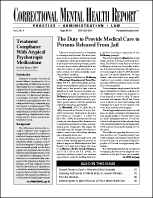ASPD Then and Now
Author: Terry A. Kupers, M.D., M.S.P..
Source: Volume 22, Number 01, May/June 2020 , pp.5-6(2)

< previous article |next article > |return to table of contents
Abstract:
There are two critical moments during a prison term where the diagnosis of ASPD has very negative ramifications for prisoners: Application for admission into prison mental health treatment and rehabilitation programs; and application for parole. Often the staff in a mental health treatment program or in a desirable rehabilitation program such as a cabinet-making or metal-working shop will decide not to admit a prisoner who has been diagnosed ASPD because he or she is likely untreatable in psychotherapy or group, or might be simply “gaming the system.” Then, when the prisoner becomes eligible for parole, the diagnosis ASPD, along with the lack of adequate treatment and rehabilitation programming, leads the parole board to label the prisoner “High Risk” and deny parole. The author has argued during the adjudication of class action litigation focused on correctional mental health treatment that individuals diagnosed ASPD can also suffer from an “Axis I” condition such as Schizophrenia or Bipolar Disorder, and I have repeatedly challenged the widely held stereotype that individuals with ASPD cannot benefit from and are resistant to mental health treatment and thus not sincerely interested in rehabilitation. With parole eligibility, risk assessment is extremely important, and the presence of ASPD, on average, leads the parole board to conclude that the prisoner is High Risk and should not be paroled.Keywords: Antisocial Personality Disorder (ASPD)
Affiliations:
1: Wright Institute.